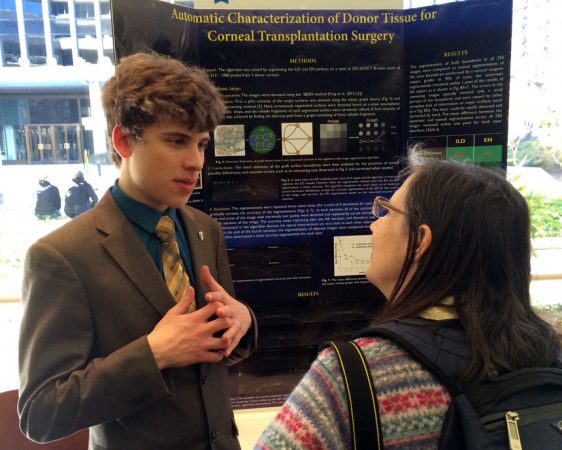Intel STS finalist uses math to help the blind
Alec Arshavsky puts his coding skill to use to help people get fitted for eye-tissue transplants
Most kids who are interested in programming might try to build an app or a game. Alec Arshavsky, 17, started out building apps, but realized he wasn’t satisfied. “You can create apps that help someone find a restaurant,” he says, “but how much impact does that have?” He decided he wanted to “write code that actually changes people lives.”
The senior at East Chapel Hill High School in Chapel Hill, N.C., used his computer programming — or coding skills — to help the blind. He presented his findings at the Intel Science Talent Search in Washington, D.C. Run by Society for Science & the Public, the Science Talent Search brings 40 high school seniors together every year to present their research findings, receive awards and even meet the President.
The cornea is the clear front part of the eye that covers the lens. Diseases like Fuchs’ dystrophy can make the cornea become thick and hard, causing blindness. Luckily, doctors can restore a patient’s sight with a corneal transplant. Many people have agreed to donate their healthy organs when they die. These can include corneas.

Right now, people called expert graders examine detailed photos of each cornea, determining its shape. It’s a long and difficult process. It can take up to three hours to complete for each cornea.
Alec wanted to speed this process. So he took a computational approach. He created a computer program that uses graph theory to examine the image of each cornea. Graph theory uses graphs to make a visual representation of some real-life situation. By analyzing the graphs, scientists can find the shortest way between two points, and use that information to solve problems. Graph theory is used in many fields, from social studies to biology.
Alec’s new program uses graph theory to seek out the lines in the images defining the edges of the cornea. Then he makes the computer program examine the image of a cornea several times. It helps provide a fairly true gauge of the cornea’s shape.
So far, Alec’s program is pretty accurate. He reported proudly that his program produces results that are just as accurate as a human grader. If he can get a more powerful computer than his old laptop on the task, the shape calculations could speed up considerably. In fact, his program is already being pilot tested at Duke University’s Eye Center.
Alec will continue to improve his program. And it’s good practice. He hopes to become a biomedical engineer one day, and use his computer programming skills to will improve people’s lives.
Power Words
app Short for application, or a computer program designed for a specific task.
biomedicine The field of research that explores the biological basis of injuries or disease and their treatments.
biomedical engineer An expert who uses science and math to find solutions to problems in biology and medicine; for example, they might create medical devices such as artificial knees.
coding A slang term for developing computer programming — or software — that performs a particular, desired computational task.
cornea The transparent front section of the eye. The shape of the cornea allows our eyes bring objects at many distances into focus.
Fuchs’ dystrophy A genetic disease that slowly destroys the cornea of eye, causing blindness.
graph theory A graphing of objects or conditions in a way that will allow analyses of relationships between two or more things. Graphs can be used to model anything from the speed of a car over time to the beating of a heart to the curve of your eyeball.
lens (in biology) A transparent part of the eye behind the colored iris that focuses incoming light onto the light-absorbing membrane at the back of the eyeball. (in physics) A transparent material that can either focus or spread out parallel rays of light as they pass through it.







